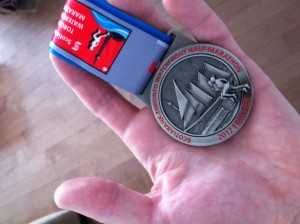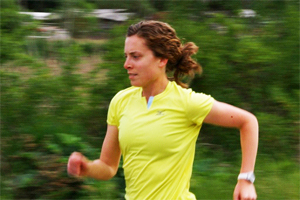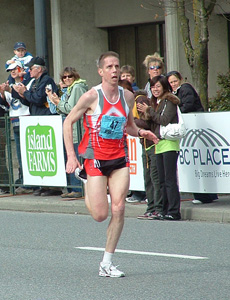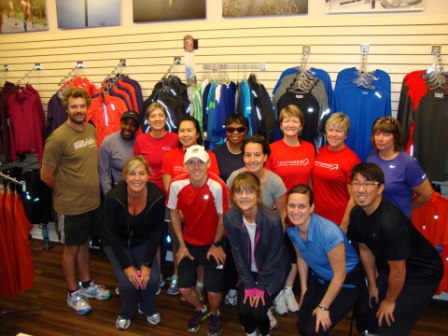Okay friends, get comfy, this is a long post…
Last night I ate my pre-race pasta dinner, fussed over my clothes, prepared my shoes and went to bed early in anticipation of race day. For the past 20 years, this kind of activity would have seemed like a waste of a perfectly good, made for drinking, Saturday night. If it was Saturday night and I wasn’t working, I would have been waiting for the beer to chill or the wine to breathe.
I had a lot of good times sharing drinks with friends and by myself (my husband always said I was my own party). I could not have had drinks Saturday night and been up at 5:30am to run; times have changed. I really, really miss a great glass of wine, or the whole bottle, but the more I run and the better I get, the happier I am with trading my drunken dancing shoes for my sober running shoes.
This morning didn’t go as planned. I set my alarm for 5:30, but apparently I didn’t turn it on. My bleary eyed husband Mike woke me at 6:00 wondering if we were skipping the race. At this point, I could have had a meltdown, but for some reason and very out of character for me, I didn’t. I got it together and in less than 30 minutes, we were out of the house (this rate of movement in the morning is a challenge for my sloth husband, bravo to him for picking up the pace). Mike was confident that he could get me to the yellow race coral, to start the Scotiabank Toronto Waterfront Half Marathon, on time. I was doing my best to “keep calm and carry on”. I couldn’t recall ever drinking this early in the day, unless it was because I was still drinking from the night before, but for a split second, my brain said “I need a drink to handle this”. My brain jumps in and takes any opportunity to try to persuade me to give the booze a second chance.
We arrived on time, and without a blood alcohol level. The rain was persistent as we approached the start, but mercifully ceased just before the horn sounded. The day before, no less than 10 people announced that it was going to rain on my race. Obviously, not a single runner existed among these attempted bubble busters; otherwise they would have understood that running, like boozing, is an all-weather sport, and that I needed a precipitation report like I needed to know about a sale at the liquor store.
As I fought my way through the crowd to my start corral, I saw my Running Room marathon clinic coach, Roger Ison. He was not running. He was hanging around trying to see as many of the clinic runners as possible. Seeing him and having him give me last minute advice boosted my confidence. I was swallowed up by the crowd of runners, all waiting to get moving. I heard a sharp whistle and looked up in its direction to see Roger standing high above the fence that enclosed the runners from the spectators. He motioned me over and then pointed me in the direction of the 2 hour pace bunny. “Get right up there” he said. I pressed my way through the runners who were packed in, shoulder to shoulder. I stood behind that pace bunny and at that moment, alcohol was the farthest thing from my mind. Thank you, Roger.
The course was great. The spectators, volunteers and entertainment really made a difference. Hearing “go Christa go” being called out on a microphone puts a bit more pep in the step. The signs along the route saying things like “run like you stole it” or “go random stranger go” are priceless.
On Bathurst, at around 5 or 6k, I ran by a Beer Store. This used to be my favorite store, formerly known as the Brewers Retail. I was enraptured by the picture of the frosty glass of beer above the door. I pulled my attention away from the hypnotizing image and reminded myself about my new favorite store, The Running Room. I conjured new images of running gadgets, shoes and clothes…crisis averted.
Within the next couple blocks, I was challenged again. I felt like turning around and hitting that Beer Store. I looked up and saw Toronto Western Hospital so close I could reach out and touch it. Tears sprang to my eyes, nausea and shaking overcame me and small sobs escaped my throat. Full streams of tears formed and blurred my vision before running down my cheeks. Eleven and a half years ago my Mom was airlifted to this hospital from Midland to undergo emergency surgery for a massive brain aneurysm. She never recovered and 18 hours after she arrived there, we stood by her bedside, while at 47 years old, her life support was withdrawn. I was 28 years old, an only child and 5 months pregnant with my first child. Today at about 6k, I needed a drink to soothe that heartache. The unexpected violent grief I felt was devastating. Alone, among 20,000 people, I felt lost. I badly wanted to pull a “U” turn and head back in the direction of self-medication.
Instead, I ran toward the 7k marker. I ran knowing that she was the strongest woman I have ever known and that I am my Mother’s daughter. I lifted my head and dried my tears and I carried on and each time I felt like slowing, I thought of her, knowing that she would never have eased off of any goal she set for herself.
I didn’t finish sub 2 hours, today, like I wanted to. I did run a personal best and took about 6 minutes off my time from last year. I have seen some Facebook and Twitter posts from some Elite runners commenting that conditions were bad today and it wasn’t a day for “PB’s”. As far as I am concerned, any day is a good day to run and today was no exception.
Great job Alan Brookes and Canada Running Series.
Thanks Mom xo
 VICKY: I agree. Running on the roads is a bore. Well, at least for me it is. I was out for our traditional Thanksgiving hike at the Dundas Conservation Area with my spouse and 3 lovely bonus children and I concur that there is nothing quite like being out in the woods and breathing that fresh air.
VICKY: I agree. Running on the roads is a bore. Well, at least for me it is. I was out for our traditional Thanksgiving hike at the Dundas Conservation Area with my spouse and 3 lovely bonus children and I concur that there is nothing quite like being out in the woods and breathing that fresh air.






 Nikki Reiter holds a master’s degree in biomechanics and is a Mizuno Running Brand Ambassador and the Women’s Cross Country Running Head Coach at the University of British Columbia Okanagan campus in Kelowna, BC. She is also the Laboratory Coordinator in the School of Health and Exercise Sciences at UBC Okanagan where she facilitates undergraduate laboratory learning.
Nikki Reiter holds a master’s degree in biomechanics and is a Mizuno Running Brand Ambassador and the Women’s Cross Country Running Head Coach at the University of British Columbia Okanagan campus in Kelowna, BC. She is also the Laboratory Coordinator in the School of Health and Exercise Sciences at UBC Okanagan where she facilitates undergraduate laboratory learning. Despite the name,
Despite the name,  Fast forward a few years, and Bustos is showing no signs of slowing down; he has represented Canada several times in international masters championship races. In 2005, for example, he won his age group in the half marathon and placed third in his age group in the 1500m at the World Masters Games in Edmonton.
Fast forward a few years, and Bustos is showing no signs of slowing down; he has represented Canada several times in international masters championship races. In 2005, for example, he won his age group in the half marathon and placed third in his age group in the 1500m at the World Masters Games in Edmonton. By: Mark Bomba
By: Mark Bomba

 Our Magazine
Our Magazine
